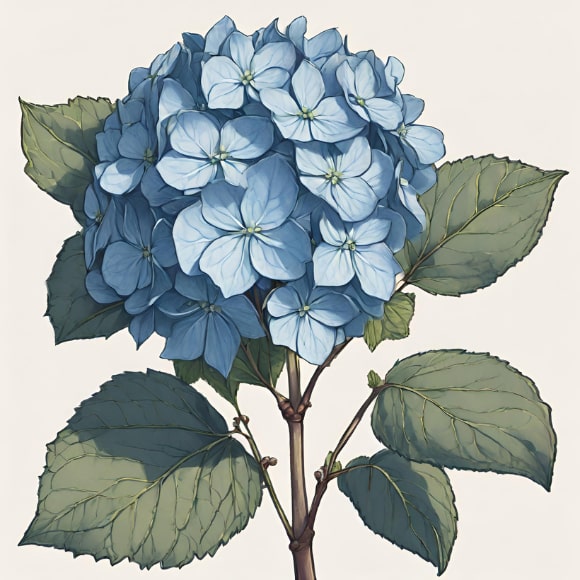
Mophead Hydrangea, a type of bigleaf hydrangea, is a stunning flowering shrub celebrated for its large, globe-shaped flower clusters and lush, dark green foliage. This popular deciduous plant belongs to the Hydrangeaceae family and is cherished by gardeners for its versatility, vibrant blooms, and ability to thrive in a variety of settings. Understanding its specific requirements and characteristics is crucial for cultivating a healthy and flourishing Mophead Hydrangea in your garden.
Botanical Features
Mophead Hydrangea is characterized by its robust, rounded shape and large, serrated leaves that can grow up to 6 inches in length. The plant typically reaches a height and width of 3 to 6 feet, creating a compact yet impactful presence in the garden. The most distinctive feature of this hydrangea variety is its massive flower clusters, which resemble pompoms or mopheads, hence the name. These blooms can span up to 8 inches in diameter and come in a spectrum of colors, including shades of pink, blue, purple, and white. The flower color is influenced by the soil pH, with acidic soils producing blue blooms and alkaline soils yielding pink ones.
Soil Requirements
One of the key factors in successfully growing Mophead Hydrangea is understanding its soil preferences. These hydrangeas thrive in well-draining, nutrient-rich soil with a slightly acidic to neutral pH. Ideally, the soil pH should range between 5.5 and 6.5 for optimal growth and flower color development. It’s crucial to note that soil pH plays a significant role in determining the color of the hydrangea blooms. To achieve blue flowers, lower the pH by amending the soil with aluminum sulfate, and for pink flowers, increase the pH by adding lime.
Best Plant Hardiness Zones
Mophead Hydrangeas are well-suited to a range of hardiness zones, with their adaptability making them popular across various regions. Generally, they thrive in USDA hardiness zones 5 to 9. However, it’s essential to consider specific microclimates within these zones, as factors like elevation, proximity to large bodies of water, and local weather patterns can influence the plant’s success.
Sun Exposure
Mophead Hydrangeas are versatile when it comes to sun exposure, but they generally prefer partial shade. While they can tolerate full sun in the morning, providing some afternoon shade is beneficial, especially in regions with hot and intense sunlight. In areas with scorching Summers, planting them where they receive filtered sunlight or dappled shade helps prevent stress and sunburn. However, in cooler climates, they can tolerate more sun. Striking the right balance between sunlight and shade is crucial for optimal growth and prolific blooming.
Watering Requirements
Proper watering is essential for the health and vigor of Mophead Hydrangea. These plants prefer consistently moist but not waterlogged soil. During the growing season, which typically spans Spring to early Fall, provide a deep and thorough watering at least once a week. Mulching around the base of the plant helps retain moisture, regulate soil temperature, and suppress weeds. However, it’s important to avoid overwatering, as overly saturated soil can lead to root rot and other fungal diseases. During dry spells or periods of extreme heat, increase the frequency of watering to keep the soil consistently moist.
Maintenance Tips
Mophead Hydrangeas are relatively low-maintenance, but a few care practices can enhance their performance and appearance.
Pruning
Regular pruning is beneficial for shaping the plant, removing dead or weak branches, and encouraging robust growth. Prune the hydrangea in late Winter or early Spring, cutting back old wood to promote new shoots.
Fertilization
Apply a balanced, slow-release fertilizer in early Spring to provide essential nutrients for healthy growth and abundant blooms. Follow the manufacturer’s recommendations for application rates based on the size and age of the plant.
Mulching
Mulch around the base of the plant with a 2 to 3-inch layer of organic mulch, such as shredded bark or compost. Mulching helps retain moisture, suppress weeds, and regulate soil temperature.
Winter Protection
In colder climates, consider providing Winter protection by covering the base of the plant with a layer of mulch and wrapping the branches with burlap to shield them from harsh Winter winds.
Landscaping Uses
Mophead Hydrangeas are versatile and can be incorporated into various landscaping settings to add beauty and charm. Here are some landscaping uses for this stunning hydrangea variety:
Foundation Planting
Placing Mophead Hydrangeas near the foundation of a house or other structures softens the lines and adds a touch of elegance to the landscape.
Mixed Borders
These hydrangeas work well in mixed borders, combining harmoniously with other shrubs, perennials, and ornamental grasses. Consider planting them alongside plants with contrasting foliage colors and textures for a visually appealing display.
Container Gardening
Mophead Hydrangeas can be grown in containers, making them suitable for patios, balconies, or small gardens. Use a high-quality potting mix, and ensure the container has drainage holes to prevent waterlogging.
Mass Planting
Create a breathtaking display by mass planting Mophead Hydrangeas in clusters. This approach is particularly effective in larger garden spaces, where the collective impact of their blooms can be truly spectacular.
Cut Flower Gardens
Harvesting Mophead Hydrangea blooms for cut-flower arrangements allows you to enjoy their beauty indoors. The large, showy flowers make a striking addition to bouquets and floral designs.
Mophead Hydrangea is a captivating and versatile shrub that can elevate the aesthetic appeal of any garden. By providing the right soil conditions, sun exposure, and watering regimen, along with thoughtful maintenance practices, you can enjoy the lush foliage and vibrant blooms of this hydrangea variety. Whether used as a focal point, a border plant, or a container specimen, Mophead Hydrangea adds a touch of elegance and charm to outdoor spaces, making it a favorite among gardeners of all skill levels.


 Previous
Previous

